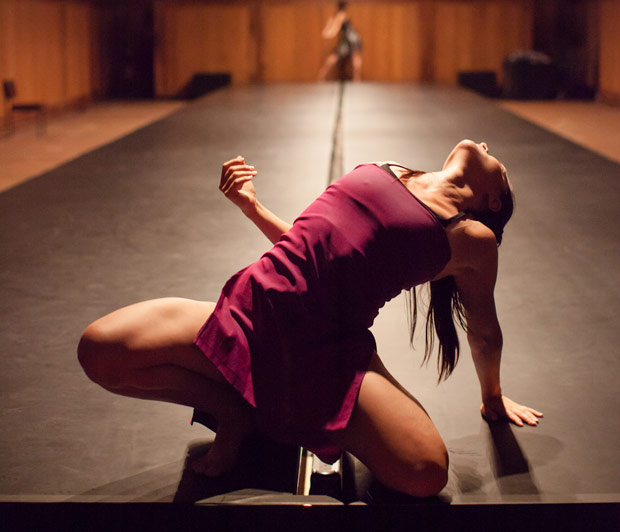
© Akiko Miyake. (Click image for larger version)
Venice Biennale Danza 2016
Part 1 of 2 reviews of the festival. Part 2.
Daniele Ninarello and Dan Kinzelman: Kudoku, ★★★★✰
Nacera Belaza: La Traversée, Sur le fil, ★★✰✰✰
Emanuel Gat: Sunny, ★★★✰✰
Shobana Jeyasingh: Outlander, ★★★★✰
Anne Teresa De Keersmaeker: Vortex Temporum, ★★★★✰
17 – 26 June 2016
www.labiennale.org/en/dance
The Venice Biennale is known best for its contemporary art festival, but it is in fact an umbrella of separate biannual festivals also encompassing cinema, architecture, music, theatre and dance, in alternating years. This year’s week-long dance festival is the fourth (and last) under the directorship of Virgilio Sieni, who has made a point of interspersing the international theatre performances with open-air presentations by apprentice dancers across the city squares as a way of connecting the festival with its locality – for international art festivals can otherwise feel strangely dislocated, with visitors checking in to a beautiful setting and checking out again once the season’s over.
Venice is, though, an undeniably beautiful setting. The opening performance took place in a gallery of the sumptuous Teatro La Fenice – a treat in itself before the piece had even begun. All credit, then, to dancer Daniele Ninarello (Italy) and American jazz musician Dan Kinzelman for making the space their own in their dynamic double act titled Kudoku. Kinzelman uses live wind instruments, a mixing deck and a loop station to transfigure the atmosphere with woodland hoots, rustles and calls, at first tranquil but building towards a cacophony of sound before dropping to a tense thrum. When Ninarello steps into this space, it’s as if his body has become the container for all that stormy sonic energy: he doesn’t actually move much, but his torso pops and pulses, his limbs flick, his head twitches. Something inside him seems to be trying to get out.

© Luna Cesari, courtesy Venice Biennale. (Click image for larger version)
Again, the energy builds, as Ninarello starts to step out, Kinzelman trailing him with crackles and jolts. Again there’s a sudden quiet, and another slow crescendo, Ninarello seeming first to follow the lines of his own arms, then to careen through the space as if hurtling through a maze of imaginary tunnels as labyrinthine and as disorienting as Venice itself. He emerges finally with a series of circling turns, like a leaf spiralling in the vortex of Kinzelman’s updraft of sound. Though its end feels overly abrupt, Kudoku is a piece that captures you not only by the way it marshals its considerable energies, but by its unwavering attention to detail in sound, light and motion.
The double bill of La Traversée and Sur le fil by Nacera Belaza (France) is unwavering to different effect. Each of these trios comprises a single dance motif: drifting rotations in the first piece, skittery steps with spiralling arms in the second. The stage is shadowed, brightening only to a kind of twilight, so that the dancers are always looming from and receding into darkness. The sound is a background texture that evolves as incrementally, as imperceptibly as the changing patterns of movement and light. In the first piece it is an ambient environment of sonic smudges and blips; in the second, a texture of syncopated rhythms and distant chants. Both are relentlessly repetitive, minimally changing, creating textures rather than dramas. The effect is either pleasantly hypnotic or maddeningly mind-numbing depending on your state of mind, and if you’re watching at the end of a long day it’s possible that it might induce a few moments of sleep. Just saying.
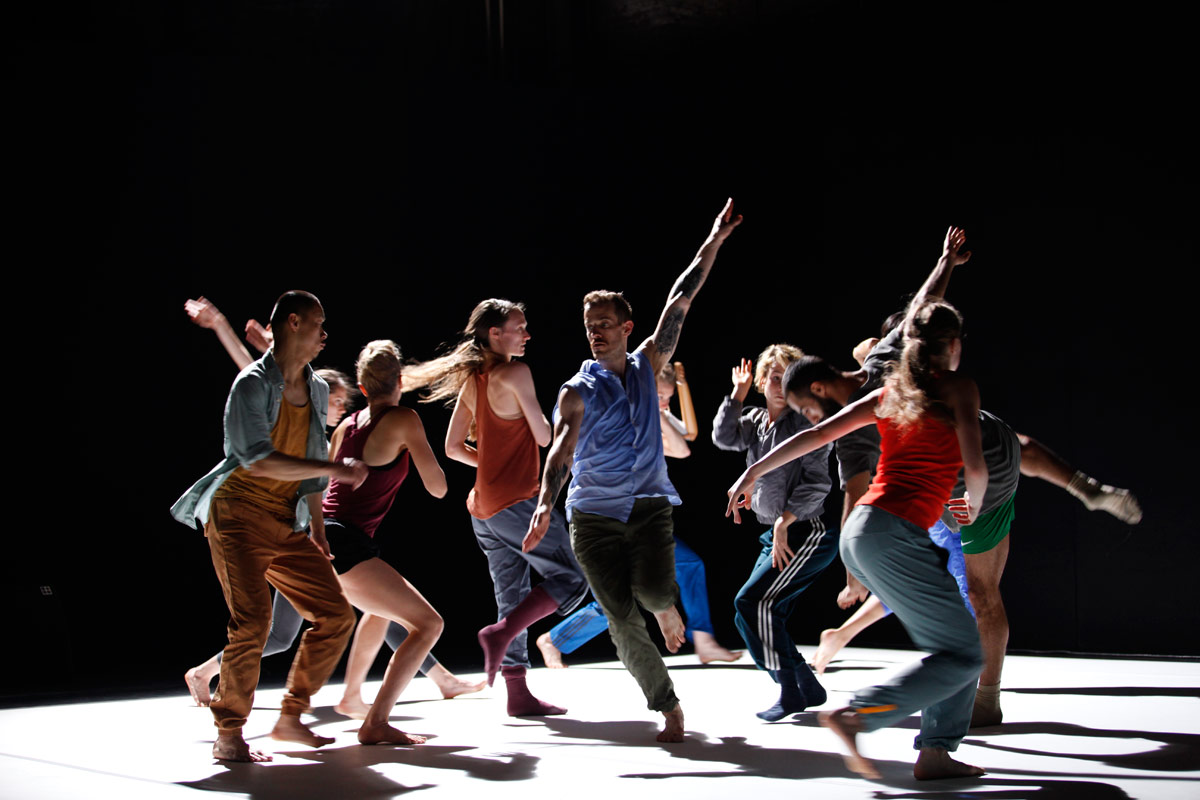
© Emanuel Gat Dance. (Click image for larger version)
Sunny by Emanuel Gat (France) is another piece connecting movement to music – here, a kind of chill-out beach rave by DJ and singer Awir Leon, swaying at a mixing deck towards the back of the stage. The sound score leads, somewhat inevitably, to the feeling of a playlist – each scene a separate “song”, one trancey, one dreamy, one upbeat and so on – but the choreographic material is far more connected, thanks to Gat’s awesome compositional skills. Typically, he’ll work with loose clusterings of dancers, galvanised by the scattershot motifs that he sends ricocheting among them: vertiginous pitches, tiny touches, high kicks, stillnesses, raised hands, headstands. So although each scene has its different character – convivial, intimate, animated – the recurrent motifs make the material both coherent and varied. The ragged dynamics also force the dancers to be on high alert at all times – their cues are constantly coming from elsewhere within the group – which brings a bracing, in-the-moment feel to the action.

© Emanuel Gat Dance. (Click image for larger version)
Yet the piece sags considerably in later sections that strain for significance in some laboured duets, and in the portentous robing and disrobing of the dancers in outlandish costumes: a woman in a tinselly raiment of red, fantasy characters in glam-rock boots and comic-strip catsuits. You might think of the DJ as a kind of urban shaman conjuring up these totemic figures, but there seems little motivation for their appearance, certainly no development of their presence on stage; the work dissipates its own energies. Still, the performance in Venice was the world premiere, and I imagine a fair few edits will be made before it tours.
Outlander is British choreographer Shobana Jeyasingh’s second Venice Biennale commission. Where the first – TooMortal, from 2012 – was designed for the nave of a humble church, this new piece was made for a far grander setting: the refectory of the Basilica of San Giorgio Maggiore. Covering the far wall is Paolo Veronese’s vast painting The Wedding at Cana (1563), the still figure of Christ at its centre surrounded by banqueters, servants and entertainers in motion. A sumptuous and historic setting indeed.
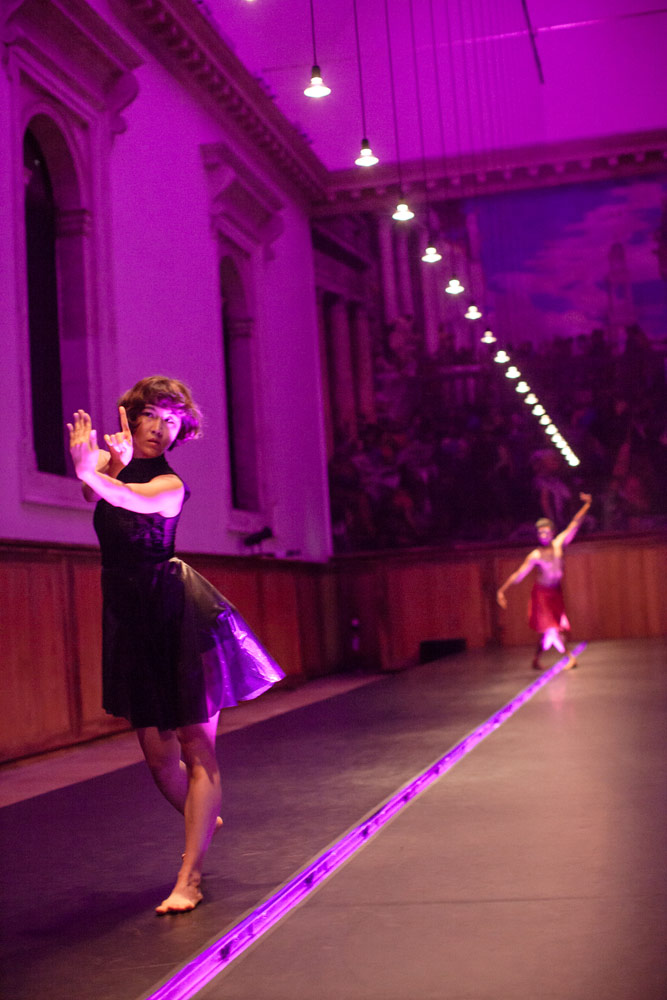
© Akiko Miyake. (Click image for larger version)
But Outlander is more riposte than homage to its location. Essentially, the piece is formed of three solos, which begin at the foot of the painting, and progress along a raised runway that bisects the hallway. The passage of the dance is determinedly away from the painting and the past, towards the exit, towards the future. Avatâra Ayuso begins the cycle with a series of mannered poses contorted into tense phrases as highly strung as the amplified, lute-like strums of Scanner’s electronic score. A row of lights suspended above the runway reveals her singular pathway out and away from the painting. Next is Sunbee Han, doll-like in a dress of shiny black plastic. Her solo is as disjointed as Ayuso’s but the tension is more machine-like than sensate, as if she’s wound up by some mechanism within. Accompanied by a spacey techno beat, she too traverses an inexorable path towards the door. The final solo, following a brief recap by Ayuso and Han, is by Sooraj Subramaniam, in a contemporary bharatanatyam style. At first he seems to be following the women’s lead and heading for the door, but he turns back to face the painting, and claims the length of the hall as his own with a contemporised bharatanatyam solo of resounding footwork and commanding poses. Having literally stamped the room with his presence, he too turns to the exit.
The one misplaced element of Outlander is an overly elaborated voiceover about a self-alienated modern man; the narrative feels intrusive. But the rest packs a punch, and I couldn’t help but think of it as the staging of an argument, between the painted figures of the past and the live figures of the present, who turn away from a history already portrayed towards the undefined world outside, towards the future.
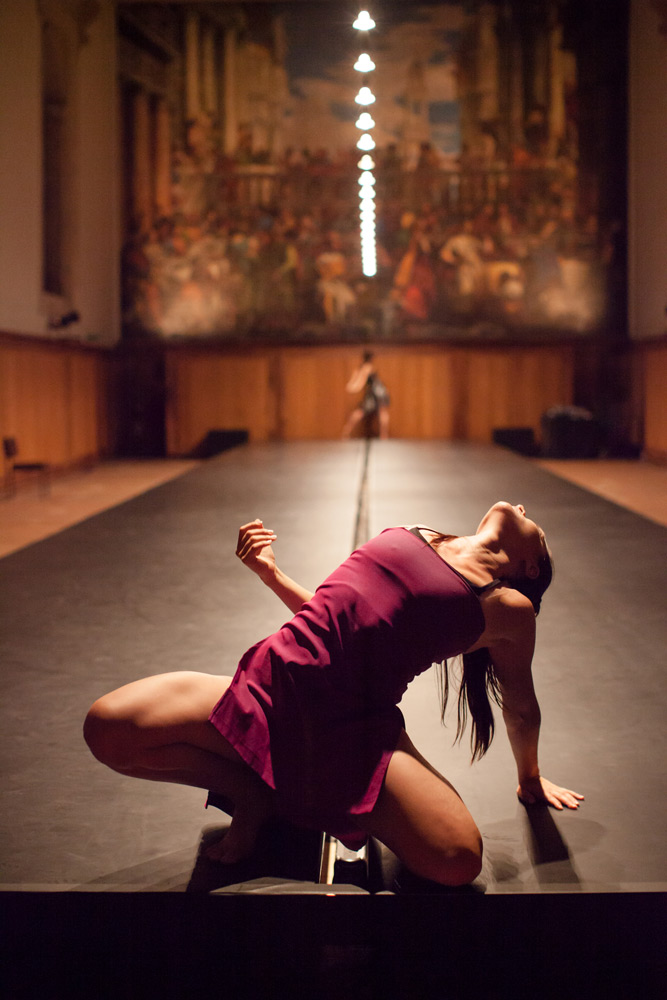
© Akiko Miyake. (Click image for larger version)
Like Jeyasingh, Anne Teresa De Keersmaeker (Belgium) has a highly compositional choreographic brain. Her 2013 piece Vortex Temporum is one of several works that anatomise the relation between music and motion, and is among her best. Both a danced concert and a concerted dance, it proceeds through four interlinked movements. In the first, music takes centre stage, with the instrumental ensemble Ictus playing Gérard Grisey’s 1996 astringent, atonal composition Vortex Temporum. They exit the stage, leaving just the pianist, thumping out a forceful solo of chord clusters before stomping out himself. It’s like a highly articulated musical door slam.
In the second section, dance takes the stage. Seven dancers occupy the same positions the musicians had done. You sense the lineaments of the music in the punctuated dynamics of their phrasing, in the harmonics of their ricocheting action, in the strike and vibration of their limbs. Just as the musicians had done, the dancers then exit to leave a single man executing a convoluted solo of directional switches, rapid rolls and flat-footed jumps. The pianist now returns and you see, with a shock, just how exactly this dense dance corresponds to that dense music. There’s no sense of hierarchy whatsoever, no sense of foreground and accompaniment: dance and music seem to emerge equally from the same wellspring.

© Anne Van Aerschot. (Click image for larger version)
The third section is the most mysterious, and the most mystical. Dancers and musicians mingle in rotating, spiral pathways around the stage. The piano itself gyrates as it orbits, like a planet, and stage lights glow and fade as if tracking a circling sun. From the spiralling piano there emerge repeated sequences of descending chords, so that the entire stage system seems to emit shifting, unknowable harmonies in both sound and space. This is the music, and the motion, of the spheres.
The final section is built on a more conventional arrangement: a line of musicians in the background, the dancers occupying the foreground space of the stage. It’s easier on the eye and the ear than the previous sections; also on the mind, because De Keersmaeker has led us to this juncture with such deliberation that we can now “see” what she is doing. Yet because we’ve had to work hard to get here (De Keersmaeker is characteristically more tenacious in the pursuit of her idea than she is concerned with gratifying her audience) there’s a real feeling of achievement, of breakthrough. We sense that this is not a piece about music and dance, nor even sound and motion, but about the more cosmic energies from which both arise.

© Anne Van Aerschot. (Click image for larger version)
I’d seen Vortex Temporum a couple of years ago, but it was well worth revisiting in Venice. De Keersmaeker must have thought the piece worth something too: Vortex Temporum forms the basis of her recent Work/Travail/Arbeid, a performative “exhibition” designed for galleries that has already been to Brussels and Paris, and comes to London’s Tate Modern on 8-10 July (New York’s MoMA is slated for 2017). I for one really want to see how that pans out.
But that’s in my home city of London. Before then, I’ll be returning to Venice – on paper only – for the second part of this festival review, to follow soon.
Part 2 of review






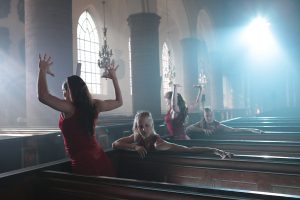








You must be logged in to post a comment.